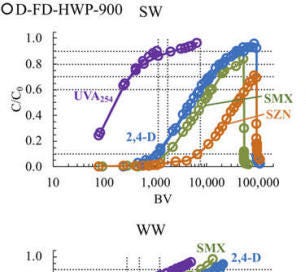For papers that are paywalled, please email us to request a courtesy copy.
Kearns JP, Gropper, A, Muñoz JL, and Yepéz P. 2023. Adaptable community participatory design to provide water that is Estético, Seguro, y Saludable (pleasant, safe, and healthy) in the Ecuadorian Amazon. Water Security 20, 100150.
Kearns JP, Kennedy AM, Shimabuku KK. Models for predicting organic micropollutant breakthrough in carbon adsorbers based on water quality, adsorbate properties, and rapid small-scale column tests. AWWA Water Science, Vol. 4, Is. 2, April 2022.
Aung MT, Shimabuku KK, Soares-Quinete N, Kearns JP. Leveraging DOM UV absorbance and fluorescence to accurately predict and monitor short-chain PFAS removal by fixed-bed carbon adsorbers. Water Research, Vol. 243, April 2022.
Bentley MJ, Kearns JP, Murphy BM, Summers RS. Pre-pyrolysis metal and base addition catalyzes pore development and improves organic micropollutant adsorption to pine biochar. Chemosphere, Vol. 286, Part 3, January 2022.
Thompson MP, Kearns JP. 2021. Modeling and experimental approaches for determining fluoride diffusion kinetics in bone char sorbent and prediction of packed-bed groundwater defluoridator performance. Water Research X, Vol 12., August 2021.
Kearns JP, Mulhern RE. 2021. Achieving safe drinking water and clean cooking for all. The Lancet – Global Health, Vol. 9, Is. 6, e755.
Kearns JP, Dickenson E, Aung MT, Joseph SM, Summers RS, Knappe DRU. 2021. Biochar Water Treatment for Control of Organic Micropollutants with UVA Surrogate Monitoring. Environmental Engineering Science, Vol. 38, No. 5.
Kearns JP, 2020. The role of chemical exposures in reducing the effectiveness of water-sanitation-hygiene (WASH) interventions in Bangladesh, Kenya, and Zimbabwe. Wiley Interdisciplinary Reviews – Water, Vol. 7, Is. 5.
Kearns JP, Dickenson E, Knappe DRU, 2020. Enabling organic micropollutant removal from water by full-scale biochar and activated carbon adsorbers using predictions from bench-scale column data. Environmental Engineering Science, Vol. 37, Is. 6.
Kearns JP. 2019. Moving towards transformational WASH. The Lancet – Global Health, Vol. 7, Is. 11, pp. e1493.
Kearns JP, Bentley MJ, Mokashi P, Redmon JH, Levine K. 2019. Underrepresented groups in WaSH – the overlooked role of chemical toxicants in water and health. Journal of Water, Sanitation and Hygiene for Development, Vol. 9, Is. 4.
Kearns JP, Shimabuku KK, Knappe DRU, Summers RS. 2019. High Temperature Co-pyrolysis Thermal Air Activation Enhances Biochar Adsorption of Herbicides from Surface Water. Environmental Engineering Science, Vol. 36, Is. 6.
Kearns JP, Krupp AS, Hartman S, Szogas K, de Boskey M, Harrington JM. 2019. Evaluation of arsenic field test kits as a learning exercise for engineering students in global water and sanitation class. International Journal for Service Learning in Engineering: Humanitarian Engineering and Social Entrepreneurship. Vol. 14, No. 1, pp. 32-46.
Kearns JP, Krupp A, Diek E, Mitchell S, Dossi S, Hartman S. 2018. Lead-lag series and staged parallel operational strategies improve the performance and cost-effectiveness of bonechar for control of fluoride in groundwater. Journal of Water, Sanitation and Hygiene for Development, Vol. 8, Is. 4, pp. 777-784.
Thompson KA, Shimabuku KK, Kearns JP, Knappe DRU, Summers RS. 2016. Environmental comparison of biochar and activated carbon for tertiary wastewater treatment. Environmental Science & Technology, Vol. 50, 11253-11262.
Shimabuku KK, Kearns JP, Martinez J, Mahoney RB, Moreno-Vasquez L, Summers RS. 2016. Biochar sorbents for sulfamethoxazole removal from surface water, stormwater, and wastewater effluent. Water Research, Vol. 96, pp. 236-245.
Kearns J, Knappe DRU, Summers RS. 2015. Feasibility of using traditional kiln charcoals in low-cost water treatment: The role of pyrolysis conditions on 2,4-D herbicide adsorption. Environmental Engineering Science, Vol 32, No. 11, pp. 912-921.
Kearns J, Shimabuku KK, Mahoney RB, Knappe DRU, Summers RS. 2015. Meeting multiple water quality objectives through treatment using locally generated char: improving organoleptic properties and removing synthetic organic contaminants and disinfection by-products. Journal of Water, Sanitation and Hygiene for Development, Vol. 5, Is. 3, pp. 359-372.
Kearns J, Knappe DRU, Summers RS. 2014. Synthetic organic water contaminants in developing communities: an overlooked challenge addressed by adsorption with locally generated char. Journal of Water, Sanitation and Hygiene for Development, Vol. 4, Is. 3, pp. 422-436.
Kearns J, Wellborn LS, Summers RS, Knappe DRU. 2014. 2,4-D adsorption to biochars: Effect of preparation conditions on equilibrium adsorption capacity and comparison with commercial activated carbon literature data. Water Research, Vol. 62, pp. 20-28.
Huggins T, Wang H, Kearns J, Jenkins P, Ren ZJ. 2014. Biochar as a sustainable electrode material for electricity production in microbial fuel cells. Bioresource Technology, Vol. 157, pp. 114-119.


